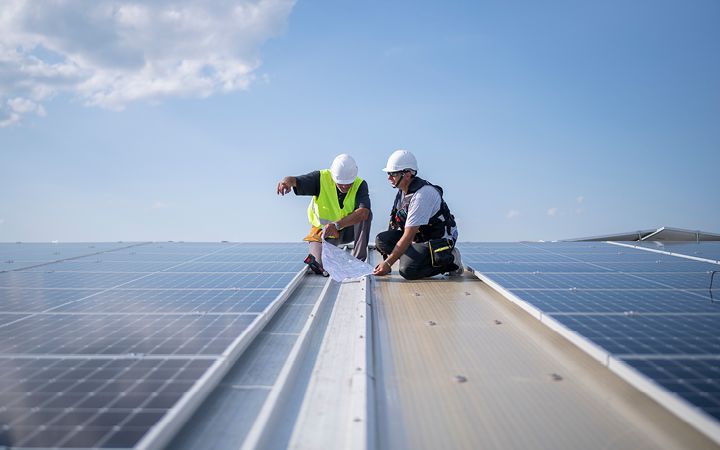How should a utility’s decarbonization and resilience planning ‘trickle down’ through the organization?
The threats that climate change poses to a utility’s assets, operations, and infrastructure are a concern that keeps many utility leaders up at night, and many have crafted goals in response. Most of those goals involve a mix of decarbonization—mitigating the long-term threats posed by climate change—and adaptation and resilience—strengthening the operation to face the threats that can’t be avoided.
For many utilities, decarbonization, adaptation, and resilience are taking a place next to reliability and profit on the top line of strategic imperatives. However, the new priorities aren’t necessarily filtering through entire organizations the way the old ones do…not yet.
Profit maximization is a perfect example of a strategic priority that every employee at every for-profit business owns. For utilities, particularly regulated entities, this profit motive manifests as a drive toward customer/shareholder value. Managers leading lines of business work to maximize revenues while their counterparts in cost centers seek to minimize costs. Reliability is more unique to the utility industry. More than a century ago, utility boards and CEOs coalesced around the imperative for safe and reliable delivery of electricity to homes and businesses. It's not unusual for board meetings and earnings calls to begin with discussions of reliability metrics. Utilities use metrics, targets, and incentives to ensure that their entire organizations row together toward success. Every other priority on a utility’s plate considers the impact on those two strategic imperatives.
The same should be the case for decarbonization, adaptation, and resilience, if utility leaders expect to achieve the ambitious climate goals many have set.
Planning for climate positions a business for success
To move decarbonization, adaptation, and resilience from abstract to action requires solid, strategic planning. Creating those plans is not easy, but it is necessary.
After Superstorm Sandy struck in 2012, Con Edison of New York, working with experts at Columbia University and ICF, established itself as an industry leader in climate change adaptation. First, the parties produced a climate change vulnerability study that evaluated how expected changes in the climate would affect Con Edison’s energy delivery systems.
The study led to the development of a climate resilience implementation plan, outlining how Con Edison would continue to adjust, as needed, its planning, engineering, operations, and emergency response practices to adapt to climate change.
Con Edison is incorporating projected changes in climate into load forecasting models and planning to install more submersible equipment to account for an expanded future floodplain. With the implementation plan, Con Edison was able to integrate its goals for resilience and adaptation into its day-to-day planning, engineering, operations, and emergency preparedness.
Use decarbonization and resilience plans to guide other critical strategies
Utilities have many priorities on their plate. At a quick glance, they include:
- Electrifying transportation, homes, and buildings
- Integrating more distributed energy resources (DERs) on the grid
- Recruiting and retaining talent in a period of major changes in the utility workforce
- Engaging customers, regulators, and other stakeholders in ways utilities have never needed to before.
Decarbonization, adaptation, and resilience plans should inform strategies for all those priorities. Doing so will align the strategies for joint success and will have the added benefit of helping filter these new strategic imperatives throughout the organization as profit and reliability already are.
Using DER planning as one example, a utility might have a decarbonization strategy in place to cut greenhouse gas emissions 50% by 2030 and a resilience strategy to limit outages in portions of the grid stressed by increased customer electric vehicle (EV) charging. If the decarbonization and resilience strategies aren’t on the table when leaders develop a strategy for DERs, they could miss opportunities to deploy innovative solutions such as solar-plus-battery-storage systems at substations and vehicle-to-grid technologies that would boost clean energy, improve resilience, and support the adoption of DERs and EVs.
Salt River Project (SRP) in Arizona offers an excellent example of this “trickle down” planning when it linked its decarbonization strategy with then-nascent electrification efforts.
In the mid-2010s, SRP began to develop plans to meet its 2035 sustainability goals. SRP identified electrification as a potential tactic to reduce carbon emissions, then worked with ICF to conduct an analysis of which customer technologies could best support the goal of beneficial electrification.
The innovative beneficial electrification program that emerged baked-in the goal of carbon reduction because decarbonization planning guided the electrification planning. Today, the electrification program has expanded to more than 550 projects and reduces carbon emissions by more than 20,000 metric tons per year.
The coming watershed of government infrastructure and climate funding from measures such as the Inflation Reduction Act and Bipartisan Infrastructure Law provides utilities a unique opportunity to build support to upgrade aging infrastructure and grow stronger relationships with customers. These funds are for everything from transportation and building electrification to DERs and energy efficiency, but they are all intended to support government decarbonization and adaptation goals, with added focus on equity and justice considerations along the way.
Utilities should follow suit by pursuing the new funding opportunities to advance decarbonization, adaptation, and resilience strategies. In doing so, they’ll adopt another practice to filter those newer imperatives through the organization’s decision-making at every step, just as with fellow top-line profit and reliability priorities.
For a deeper dive into integrated strategic planning, read our latest paper: How to align utility organizations around 7 top boardroom priorities.

